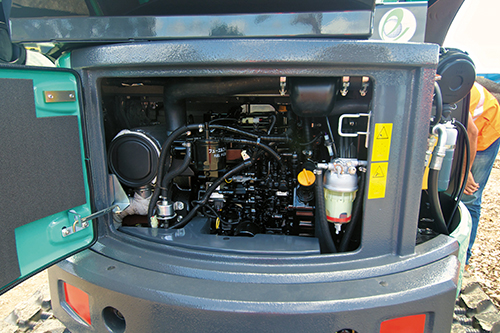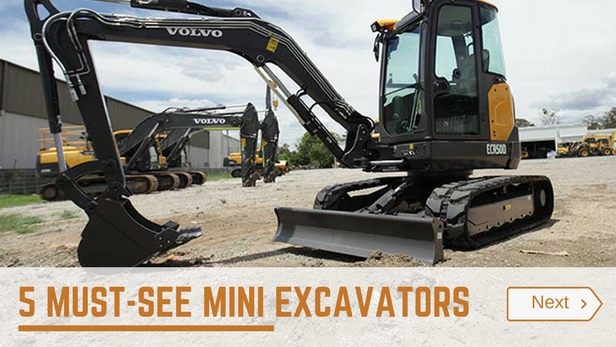The new 3.6-tonne IHI 35V4 is the only mini excavator in its class to have expandable tracks, giving it the ability to access difficult sites without losing its stability. JOSH SIMPSON put it through its paces.
BROWSE ALL IHI EXCAVATORS FOR SALE
Chipping away at the seemingly endless pile of paperwork as the New Zealand summer weather put on a stunner outside, I was slowly losing the enthusiasm to continue. As I stared out the window, the phone lit up with an incoming call.
Bauer Trader NZ’s Randolph Covich said he was heading down to Western Aggregates & Soil in West Auckland to test out the new IHI 35V4 mini excavator and wanted to know if I wanted to tag along. To his delight (probably), I jumped at the chance without knowing his ulterior motive:
“Great, you can operate the machine and write us an article as well,” he replied with great confidence.
The IHI range of excavators are made in Yokohama, Japan, and distributed in Queensland by Skid Steers Australia and in New Zealand by Youngman Richardson & Co (YRCO). The brand is, in fact, celebrating 45 years in Australia this year.
I had high expectations as I walked into the Western Aggregates yard. Now, like a book and its cover, even though the 3.5-tonne, zero-tail-swing excavator looked slick, I knew you shouldn’t judge a machine by the way it looks.
Giving me the overview of the machine was Alf Aitcheson, sales specialist in the earthmoving and roller category at YRCO. He took the opportunity to show a considerable list of features the little machine had to offer.
One thing that stood out for me straight away was the ease of access to the filters, which are placed under the large, side-opening cover and sit adjacent to the hydraulic bank and battery.
Having the battery there seems like a good idea as on some machines you need to pull the rubber floor mat out (which we all know can be a lengthy task on its own) and take out a floor panel when checking levels for maintenance. The issue I did see with this was that it could be difficult to add water to the rear battery cells, but it’s probably still better than having a battery out of sight and never checking it at all, I suppose.
The feature that stood out to me the most – and is probably the IHI 35V4’s biggest sales point, in my opinion – was the expandable tracks these machines have. Starting off at 1550mm to be in line with the cab, the tracks will expand out to 1800mm.
This feature would come in to its own when accessing difficult sites, while still offering the advantage of expanding the tracks and giving the machine a more stable footprint to work on when you start moving materials.
In the cab
Climbing into the cab, I noticed all of the normal features one would find in a modern cab, including a monitor in front of the right-hand joystick, which was easy to view without having to adjust my head too much. This had all your standard information one would expect to see – fuel level, temperature, hour meter, etc.
Moving back behind the joystick were all the switches in a nice centralised location, including the standards, along with the advantage of being able to switch between low and high flow on the auxiliary line. While on the subject of auxiliaries, I should also point out that the control lever for the auxiliary line is also on the right-hand joystick – a big plus.
Holding down the two tabs and pulling the front window pane up over my head, Aitcheson pointed out the additional two tabs on the bottom pane which give the option of pulling that above your head, opening the entire front and eliminating any chance of glare off the front screen.
On the job
We had organised with Western Aggregates to excavate a footing, which had been on their to-do list for a while. I was told that having the chance to test the digging power of this machine in virgin ground was a bit of a rarity as often there was just a stockpile to move material around on.
I set off towards the proposed footing and used the opportunity to test the travel speeds in ECO mode and VMAX mode – finding ECO mode to be just as efficient with a top speed of 4.7km/h.
Ripping the bucket into the ground, I found ECO mode to be at its limit for the dried-out, rock-like clay and switched it into VMAX mode, noticing the increased revs and power right away.
At this setting it now handled the task with ease. Extending the arm out to its full reach, I observed the longer dipper arm, which is an option in Australia but comes as standard in New Zealand, nicely paired with an additional counter weight. This only sticks out over the track by a mere few centimeters when the tracks are fully extended.
As the machine made short work of the footing (I’d like to think it was the operator, though), we had a bit more time available to excavate a trench for a waterline. This excavation work was through tightly compacted aggregate, and was another job that the machine handled well.
It wasn’t until I had excavated the trench and started the backfilling process that I came to realise the blade was still at 1550mm-wide, while the tracks were out at 1800mm, necessitating the ‘narrowing’ of the tracks to keep the machine level while blading.
The bottom line
After operating the machine for little over two hours, it was safe to say that IHI had met many of my expectations with the 35V4, as I struggled to find any real negatives.
It’s clear to see that a lot of thought has gone into the design and engineering of this machine, whether it be the expandable tracks, the interior cab set-up or the well placed components under the side and rear covers.
All in all, I found this a great, versatile machine, and with all its added extras as standard, it certainly offers good value for money. I expect to see a number of them popping up on sites in the not so distant future.







